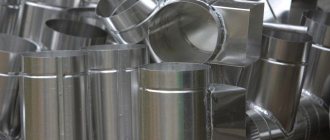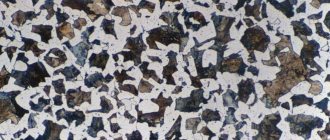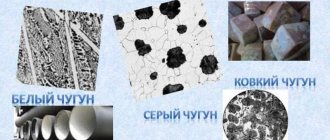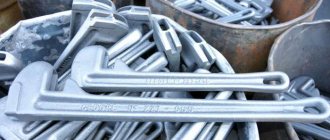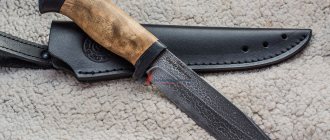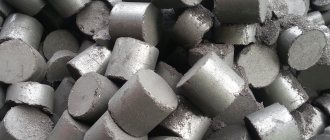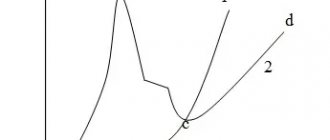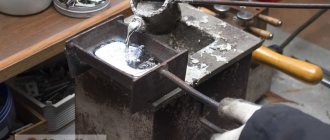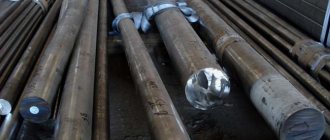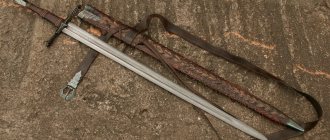How do you get damask steel?
Bulat can be obtained from some types of ordinary steel. The main condition is a low level of alloying of the material. It is impossible to obtain damask steel from high-alloy steel, and only low-quality damask steel from medium-alloy steel. Despite the fact that modern materials are superior to damask steel in their properties and do not require such complex processing procedures, there are still workshops in which enthusiasts make blades using ancient technologies. But the use of more modern tools makes it possible to smelt material of much higher quality.
In addition, many manufacturers are now adding additional elements to the alloy, which give damask steel new properties. This mainly concerns the use of chromium and nickel additives, which can significantly increase corrosion resistance. Some weapons, which are intended exclusively for collections and will not be used in staged battles, are completely covered with a layer of silver. This allows you to protect the steel from the negative effects of environmental factors. In addition, soft silver lends itself more easily to jewelry processing by applying thematic patterns or designs to the blade.
Damascus steel, unlike Damascus steel, which was also used for the production of blades, is characterized by a disorderly pattern. It is obtained as a result of crystallization of the metal lattice in the alloy.
The history of the appearance of damask steel
The first mentions of damask steel date back to the era of Alexander the Great. It was his chroniclers who spoke about wonderful blades that could easily cut iron armor and fabric flying in the air. These were the legendary damask blades, the secret of production of which the Indians did not reveal to the Macedonians.
India was the birthplace of damask steel. The secret of its production was kept in the strictest confidence, although finished damask steel ingots were exported to the East with might and main. Roughly 2,000 years ago, the Roman Empire conquered parts of the Middle East, and oriental goods poured into Europe. The main point of production of damask swords was the city of Damascus.
It’s worth stopping here and clarifying one point. Damascus never made damask steel; here they only forged swords, knives and sabers from it. In addition, many historians confuse damask steel and damascus, although these are completely different types of steel. The technology for producing damask steel consisted of alloying iron and graphite using a secret technology, and Damascus was simply forged from a package consisting of several types of steel.
Swords that were popular in the 3rd century AD are also sometimes called damask swords, but they are not even Damascus. This is a normal forge welding of hard steel in the middle and soft iron plates. Such blades were really sharp, due to the steel core, and perfectly withstood shock loads, thanks to the iron plates.
Many historians are confident that after the conquest of Rome by the barbarians, the secret of damask steel spread throughout Europe, but was lost during the Dark Middle Ages. If we consider that in those years all the barbarians were constantly at enmity with each other, then in order to lose the secret of making the best weapons in the world, they had to be destroyed every single one of them.
They say that the secret of making damask steel was rediscovered in the 16th century in Russia, but it was most likely the same Damascus.
Material production methods
There are four ways to make damask steel. The first involves direct fusion of iron ore with crushed graphite. This is the simplest method from a preparation point of view, since it does not require obtaining pure iron. But for its successful implementation, ore with a metal percentage of at least 85% is necessary, otherwise you will not get good quality damask steel.
Ores containing native sulfur, which are quite common in nature, are not suitable for this option. So getting the right material will be extremely difficult. In modern conditions, this method is not used, since finding pure iron is not a problem, but in ancient times this method was most common in blacksmithing. The second method involves melting iron with direct access to coal. In this case, not only pure carbon enters the alloy, but also its oxides, which give the metal the structure of damask steel. This method is also not used now, because it is characterized by a high proportion of impurities in the resulting material, which negatively affects its quality.
The third method is long-term burning of iron without air access. This method is the cheapest to implement and therefore is widely used. The material obtained in this way is called cast damask steel. An important condition for obtaining good material is accurate calculation of firing time. Otherwise, excess carbon may be introduced into the alloy, resulting in poor ductility and brittleness. The fourth option is the most expensive, but at the same time allows you to obtain the best quality material. It involves fusing pure iron with graphite in an airless environment. This allows you to rid damask steel of unwanted impurities and oxide additives.
Products made from damask steel of this brand are most valued among connoisseurs, so they are quite expensive. In ancient times, only wealthy warriors could afford such weapons. Nowadays, blades serve mainly as decorations that are hung on the wall. Occasionally, they can serve as historical reconstructions of famous battles of past eras. For the above purposes, the best quality damask steel is used so that the weapon looks beautiful and does not differ in its properties from the best blades of famous blacksmiths. The most expensive samples are decorated with a variety of hand-made patterns that are dedicated to the theme of battles. The handles of the blades also serve for decoration. They are made from a wide variety of materials, from skillfully crafted animal horns to precious metals. Additionally, the hilt can be inlaid with multi-colored stones.
In addition to the above methods, there was another one that was not widely used. As an experiment, metallurgists in the Soviet Union tested the following method for producing damask steel. In the first stage, pure iron or low-carbon steel was melted in an induction furnace, and then silicon and aluminum additives were introduced into the melt, after which graphite was added to the resulting alloy. The output was cast iron with 3-4% carbon content. But the smelting process did not end there.
Iron or low-carbon steel scrap was gradually added to the melt in proportions so that the mass fraction of additives was 50-70% of the mass of cast iron. After cooling and crystallization, damask steel with a high-carbon metal mesh was obtained, into which low-carbon elements were woven. The resulting damask steel had excellent properties in terms of malleability and ductility, and also showed extreme hardness. But this method did not go into widespread production due to the complexity of the technological process and the high cost of smelting. In addition, more modern and advanced materials were already known, so such costs for obtaining damask steel were rightly considered unjustified.
Iron Stream
At the beginning of the 18th century, Russian metallurgy began to develop rapidly. To implement his grandiose plans to expand the Russian state, Tsar Peter I needed a large number of high-quality weapons, and for their production they needed, first of all, iron and cast iron. Relying on domestic and foreign experience, Peter I organized iron ore mining and factory construction, unprecedented for that time. From 1700 to 1800, 123 ironworks were built in the Urals alone. By the end of the king’s life there were 233 of them, and by the end of the 18th century there were already 3,100 of them, not counting the mining factories. Pig iron production in Russia during this time increased from 150 thousand poods in 1700 to 9.91 million poods in 1800.
Abu-r-Raykhan Muhammad ibn Ahmad al-Biruni - Central Asian scientist-encyclopedist (4.09. 973 - 9.12.1048)
The victory of Russian metallurgy over Swedish was no less significant than the victory of the Russian army over the Swedes in 1721. For example, in 1716, the first batch of Russian iron in the amount of 2,200 pounds was exported to England, and in 1732, the export of iron already exceeded 200 thousand pounds. In 1722, a decree of Peter I was issued, which, in fact, gave the first technical conditions for the quality of iron:
“His Imperial Majesty ordered to send from the Berg College to all iron factories where iron is made, so that from now on the iron will be tested in this way, and released to the indicated places, and sold with the following marks.
First test: dig round pillars six inches thick in diameter into the ground so far that it is motionless, and hollow out holes in them the size of the strips, and push iron into that hole, and circle around that pillar three times, then back away from it. remove the post, and if it does not break, and there is no breaking mark, then stamp No. 1 on it in addition to the factory mark.
The second test: taking the iron strips, hit the anvil three times, then turn the other end back and hit them three times with all your might, and whichever one will withstand, and there will be no sign of a break, then each one, in addition to the factory mark, is branded with No. 2.
On the latter, which does not withstand those tests, put in addition to the factory stamps No. 3. And without stamps, strip iron should not be sold at all.”
Patterns of welding damask steel, enlarged 2-4 times
Each type of steel was rated according to its “own” number of “bends”: spring steel with six “bends”, coin steel with eight, tool and Damascus steel with twelve.
The leadership style of Peter I was also characterized by the strictest control over the implementation of his decrees. Thus, by decree dated January 11, 1723, he ordered: “The gun office from St. Petersburg should move to Tula and monitor the serviceability of the guns day and night. Let the clerks and clerks watch how Alderman places the brands. If you have doubts, check it yourself by inspection and shooting. And shoot two guns every month until they deteriorate. If a hitch occurs in the army, especially during a battle, due to the oversight of the clerks and clerks, the senior clerk will be given a job as a clerk, and the clerk will be deprived of his Sunday glass for a year.”
In the 18th century, Russia became the largest exporter of iron to Western Europe. In 1788 alone, 38.4 thousand tons of iron were exported from Russia to England and 5.8 thousand tons to other countries.
Zlatoust cavalry saber
In 1751, on November 20, the Tula industrialists Mosolovs entered into a contract with the Orenburg chancellery for the construction of an ironworks. In 1754, in the Kosotursky tract, on the Ai River, half a mile from the mouth of the Tesma River, the Zlatoust Plant was founded - one of the largest metallurgical plants in the Southern Urals. Having reached its design capacity, already in 1773 the plant was producing up to 140 thousand pounds of cast iron, 90 thousand pounds of iron and 1.885 thousand pounds of copper.
Over the course of 75 years, from 1701 to 1776, a whole complex of metallurgical plants was erected in the Urals: Nevyansky (1701), Kamensky (1701), Nizhne-Tagilsky (1725), Kononikolsky (1750), Preobrazhensky ( 1758), Verkhne-Avzyanopetrovsky (1755), Nizhne-Avzyanopetrovsky (1756), Katav-Ivanovsky (1757), Beloretsky (1761), Zlatoustovsky (1773), Miasssky (1776) . By the beginning of the 19th century, the Urals emerged as a grandiose industrial region on a global scale.
A copy of the saber of Tsar Mikhail Fedorovich, made by master gunsmith Ilya Prosvit.
Are there damask kitchen knives?
Many people ask, is it possible to make a kitchen knife from cast damask steel? This question cannot be answered unambiguously. You can make it, but before ordering such a knife, you need to carefully weigh everything:
- Not a single large knife company produces damask kitchen knives. You can say that they don’t know the secret of producing damask steel, but that’s just funny. A bunch of artisan blacksmiths know this secret, and no one wants to share it for a certain amount of money;
- Damask steel rusts, and this is very bad for a kitchen cook. Although most professional Japanese chefs work with carbon knives all their lives, and are satisfied;
- The price of a damask kitchen knife will be very high;
- A kitchen knife should not be thicker than 2 mm at the butt, and forging such a blade is very difficult;
- It will be very difficult to sharpen a kitchen utensil made of high-quality damask steel. A housewife definitely cannot cope with such work.
So it’s better to throw the idea of making a damask kitchen cooker out of your head, you don’t need it.
What to look for when choosing
To remain completely satisfied with the purchase of a damask steel knife, you need to pay attention to:
- A chaotic drawing on a dark background - lines and dots should be clear and large, but not symmetrical. Smooth and symmetrical lines are a characteristic of cheaper Damascus steel.
- The ringing of monolithic damask steel is clear and long. If the blade is not solid (layers, fluctuations of various types), the sound will be low and short.
- A responsible manufacturer always indicates the purpose of the blade - the dimensions and parameters must match. The hunting blade is longer, the fishing and tourist blade is shorter, with a folding design.
- The assembly must be of high quality without gaps, burrs, etc.
- Documentation - warranty card, certificate (confirmation that this knife is a non-bladed weapon).
- Case/case.
Sharpening features
Damask steel is extremely strong, so sharpening it at home is not easy. It's better to entrust it to a pro. Such blades are sharpened with diamond stones, or a hard stone can be used.
As for the sharpening angle, you should stick to 30-45 degrees, the thickness of the edge should not exceed 0.5-1 mm.
Sharpening a damask knife.
Simplified technology for forging damask knives
To make a damask knife using the simplest technology, a blacksmith will have to work with sponge iron. First it needs to be forged, then mixed with charcoal and placed in a crucible. A crucible is a special vessel made of refractory material that can withstand temperatures of about 1,200 degrees. In this vessel, the future damask steel is heated to these same 1,200 degrees, after which it slowly cools.
Not a single blacksmith admits what exactly is happening there; it is possible that each one adds some secret ingredient, but the result should be real damask steel. A forging is made from the finished steel, which is then used to create a knife blade.
Rules of use and care
- Since such a knife can rust, after use the steel must be cleaned, rinsed with water and wiped dry with a rag.
- Such metal products are stored in a warm, dry place, excluding the formation of condensation.
- It is better to use a leather case. For long-term storage, it is better to cover the blade with a layer of fish oil and paraffin.
- When rust appears, you need to immediately remove the deposits - kerosene is used, but aggressive agents are prohibited. You can also use fine sandpaper, but after processing you will have to etch the knife, since the design will fade.
